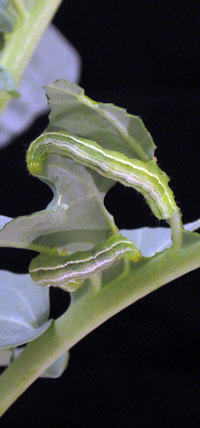Researchers identify how insects resist Bt pesticides
By Krishna Ramanujan

For the first time, researchers have identified how cabbage looper caterpillars in the field develop resistance to the bacterium Bacillus thuringiensis (Bt), which naturally occurs in the soil and on plants and has been developed into the most successful and widely used biological insecticide.
When ingested, the insecticidal toxins in Bt kill insects by destroying their guts. Insects in the field develop resistance to it, however, via a genetic mechanism that alters a toxin receptor in the insect's gut, two Cornell researchers have discovered. The receptor belongs to a class of digestive enzymes called aminopeptidase N (APN), two of which undergo changes when cabbage loopers develop resistance to Bt on crops.
Under normal circumstances, the Bt toxin Cry1Ac, which is a caterpillar-specific toxin, binds to an enzyme called APN 1 along the wall of the insect's gut, where the toxin destroys the gut lining. But when cabbage loopers develop resistance, APN 1 significantly decreases while another aminopeptidase, APN 6, which does not bind to Bt, significantly increases, allowing the insect to properly digest food and Bt without harm.
"If an insect loses an aminopeptidase N, you will expect to see an negative effect on the physiology of the insect gut," said Ping Wang, associate professor of entomology and senior author of the paper published online in the Aug. 15 issue of the Proceedings of the National Academy of Sciences. Kasorn Tiewsiri, a postdoctoral associate in Wang's lab, is the paper's lead author.
"To compensate for the loss of the enzyme APN 1, the activity of APN 6 jumps up high, and that allows the insect to perform a normal digestive process, where Bt no longer binds to the gut," Wang added.
Organic farmers use Bt as a key weapon against insects, and crops genetically engineered with insecticidal Bt genes are now sown on 59 million hectares (more than 145 million acres) worldwide.
Farmers first reported Bt resistance in the field 20 years ago. Since then, researchers have uncovered a number of mechanisms for resistance in insects in the lab, but then learned that lab insects, which don't face the same stressors as field insects, develop different tactics for overcoming Bt.
In this study, Wang and Tiewsiri obtained cabbage loopers from greenhouses in British Columbia that were resistant to Bt and crossed them with a lab strain that had no resistance. The progeny carried the isolated Bt-resistant trait from their field-stressed parent. The researchers then used that line of cabbage loopers to conduct biochemical, proteomic and molecular studies.
Next, the researchers plan on trying to identify which gene mutates in the Bt-resistant insects, how that gene controls the expression of targeted proteins, and uncover resistance mechanisms to other Bt toxins, as many varieties are used in agriculture. The researchers hope their studies will lead to new management strategies for Bt-resistant insects, Wang said.
The study was funded by the U.S. Department of Agriculture's National Institute of Food and Agriculture.
Media Contact
Get Cornell news delivered right to your inbox.
Subscribe